Vinchio Vaglio
(An Online Virtual Visit)
by
Kathy and Terry Sullivan
Photos provided by
Vinchio Vaglio unless otherwise noted.
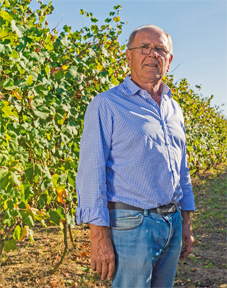 This article describing Vinchio Vaglio is based on the online interview, online data and photos supplied by Vinchio Vaglio. We also received four wine samples. This article was written during the time of the world-wide 2020-2021 pandemic. Lorenzo Giordano, President and Tessa Donnadieu, export manager kindly responded to our questions.
This article describing Vinchio Vaglio is based on the online interview, online data and photos supplied by Vinchio Vaglio. We also received four wine samples. This article was written during the time of the world-wide 2020-2021 pandemic. Lorenzo Giordano, President and Tessa Donnadieu, export manager kindly responded to our questions.
Summary: Vinchio Vaglio is a wine cooperative created by farmers in two villages (Vinchio and Vaglio Serra.) The cooperative focuses on producing wines with Barbera which is 70% of the production. The cooperative is located in a UNESCO World Heritage Site.
The cooperative would like the public to know how important Vinchio Vaglio is to the two villages where the majority of the vineyards are located. Lorenzo responded, “Our cooperative identifies the two villages Vinchio and Vaglio Serra where more than 90% of the production is all delivered to the cooperative and is the only production unit on which the social-economic development of two villages depends.”
History of the Vinchio Vaglio Cooperative
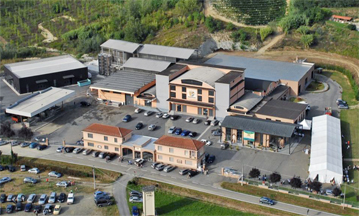 The wine cooperative was created in 1959 by grape growers whose vineyards were too small to craft their own wines. According to Tessa these small growers did not have the necessary capital to build their own winery.
The wine cooperative was created in 1959 by grape growers whose vineyards were too small to craft their own wines. According to Tessa these small growers did not have the necessary capital to build their own winery.
Lorenzo wrote about the benefits of a wine cooperative. “Yesterday's wines were disharmonious between acidity, alcohol content and colour at a time quantity prevailed over quality. More than 40 years ago, the cooperative had the foresight to start with qualitative projects. Thanks to the expertise of its vine growers and thanks to the favourable soils where the Barbera vine expresses the maximum potential and thanks to the best technicians and the best technology available on the market we were able to obtain balanced and drinkable wines which can compete with the most important wines in the world today.”
Today, Vinchio Vaglio has 192 participating grape growers. Additional grape growers who agree with the vineyard management protocol are welcome to join the cooperative. The range of ages of the growers is wide. Ages range between under 40 years of age to the 90 year olds who continue to cultivate their own vineyards.
Lorenzo described his own passion for wine. “In our territory, each wine grower use to vinify his own grapes at home and the cooperative continues this tradition of a family business. When I was a child I used to go secretly in the facility of the cooperative to follow the work in the cellar (crushing, vinification...) but it was forbidden for us children as it was dangerous. I remember the smell of the harvest and the must in the air.”
Vineyards
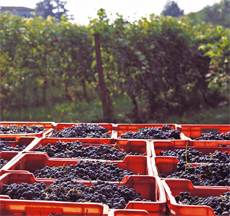 The grape growers have a total of 470 hectares (1161 acres). “The main grape varieties are Barbera (70% of the production), Dolcetto, Nebbiolo, Albarossa, Ruché, Grignolino, Pinot Nero, Freisa, Bonarda, Chardonnay, Cortese, Sauvignon, Viognier, Arneis, Moscato, and Brachetto.
The grape growers have a total of 470 hectares (1161 acres). “The main grape varieties are Barbera (70% of the production), Dolcetto, Nebbiolo, Albarossa, Ruché, Grignolino, Pinot Nero, Freisa, Bonarda, Chardonnay, Cortese, Sauvignon, Viognier, Arneis, Moscato, and Brachetto.
The soils in the area vary. At the bottom of the valley the soil is not good for grape growing and therefore the region’s vineyards are located on the slopes of the hills. The basic description of the hill soil included lack of minerals and organic materials. The vineyard soils are divided into three types: “white lands,” “red lands,” and “Astiane sands.”
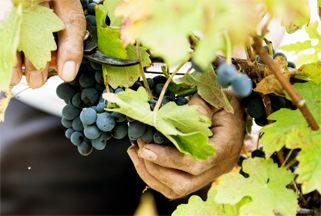 “The “white lands”, which characterize the Canelli, Alto Monferrato and Casale districts, have plenty of lime, clay and stones, with rock fairly close to the surface. They are typical calcareous-marl soils, white, light grey or beige in colour and rich in calcium carbonate. They are ideal for growing wines and produce full-bodied, rich coloured (red) wines, sometimes with a scent of marl, which enjoy a long cellar life.”
“The “white lands”, which characterize the Canelli, Alto Monferrato and Casale districts, have plenty of lime, clay and stones, with rock fairly close to the surface. They are typical calcareous-marl soils, white, light grey or beige in colour and rich in calcium carbonate. They are ideal for growing wines and produce full-bodied, rich coloured (red) wines, sometimes with a scent of marl, which enjoy a long cellar life.”
"The “red lands”, found especially in certain areas of the Alto Monferrato district, are deeper and richer, not only in clay and lime, but also in iron oxides and magnesium, with a lower alkaline content.” This area is the best for white wines.
“The “Astiane sands” are spread throughout the centre of the Monferrato Astigiano district, on the right and left banks of the River Tanaro, and produce excellent, red wines characterized by a low acid content and accelerated maturity.”
According to Tessa the vineyards have 90% of the Piedmont indigenous grapes which includes Barbera.
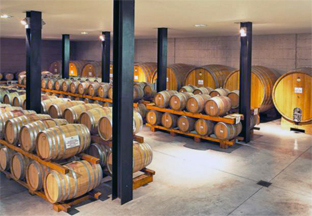 Winery
Winery
The cooperative winery works with the best grapes from the growers’ vineyards. The sugar level is checked and there are measuring stations. Lorenzo noted: “It is not only the sugar level that is assessed, but there are measuring stations that can 'X-ray' the grapes to assess the quality potential in depth, measuring five, six or more parameters in a short time, and many different processing lines to which the different lots are sent. But above all, the real revolution has been the return to the vineyard: agronomic technical assistance services to advise on what to plant and how, how to defend against disease, using weather networks and forecasting models, how to improve grape quality and choose in advance the vineyards destined for selection.”
Vinchio Vaglio Wines
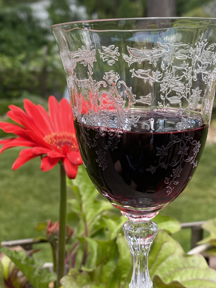 We were fortunate to receive a sample box of four Vinchio wines (pictured right, photo Wine Trail Traveler). This was part of the Hopwine Fair that took place in March 2021 online. Each sample was 20 ml enough for a tasting.
We were fortunate to receive a sample box of four Vinchio wines (pictured right, photo Wine Trail Traveler). This was part of the Hopwine Fair that took place in March 2021 online. Each sample was 20 ml enough for a tasting.
The 2019 Sorì Dei Mori, Barbera d’Asti D.O.C.G. had 13.5% alcohol and was made with 100% Barbera grapes. The wine had a dark ruby color with a dark pink hue. The aroma was floral, like a peony, and fruity. The taste included black cherries, blackberries and spices. The wine was full bodied and had medium/bold tannins. The finish was fruity. Pair with white meats, vegetables and foods with tomato sauces.
The 2018 Vigne Vecchie 50, Barbera d’Asti D.O.C.G. had 14.5% alcohol wine. It was produced with Barbera grapes and aged in stainless steel tanks. The wine had an opaque garnet color. The aroma offered red berry fruits. The taste was reminiscent of red cherries and red plums. The wine had a full body and bold tannins. The finish had fruit yielding to mineral. Pair the wine with red meats.
The 2018 I Tre Vescovi, Barbera d’Asti Superiore D.O.C.G. had 14% alcohol. This wine was crafted entirely of Barbera grapes. The wine was aged in French oak casks. With its opaque ruby color, the wine had garnet hues. Spices and red fruits were on the aroma. The taste included red cherries, red raspberries and baking spices. The wine had a full body with bold tannins. The wine would pair with many pasta dishes with red sauces as well as red meats and blue cheese. The name of the wine “I Tre Vescovi” comes from the area where three towns meet: Acqui Terme, Alessandria and Asti.
The 2016 Laudana, Nizza Riserva D.O.C.G. had 14.5% alcohol. The wine was aged for 18 months in French oak and additional time was spent in cement tanks and bottles. The name “Laudana” refers to a ridge between Mombercelli and Vinchio. The wine had an opaque dark ruby color. Dark fruits are on the aroma while the taste offers black cherries, blackberries, spices and caramel. The wine had a full body and bold tannins. On the finish, fruit yielded to baking spices. Pair with stews, red meats, game and aged cheeses. For dessert, pair with caramelized apples.
Wine and Food Pairings
The four wines we tasted from Vinchio Vaglio were all produced with Barbera grapes. Tessa suggested pairing these Barbera wines with braised/roasted red meat dishes and game. She also suggested lasagne and tagliatelle with mushrooms. Cheeses were also mentioned including descriptions of mature, spicy and blue.
Numerous other local foods to pair with wines from Vinchio Vaglio included:
gnocchi with meat sauce
square agnolotti,
sancrau: braised cabbage with garlic and anchovies
baciuà - pig trotters
bagna cauda - a dipping sauce
mixed boiled meats
mixed fried foods
risotto
pasta and beans
chickpeas and pork ribs
finanziera - ancient stew from the Piedmont
Tourism
Visitors to Vinchio Vaglio can choose to partake in numerous activities. Tours of Vinchio Vaglio are available in Italian, French and English. The wine shop is open seven days a week. Throughout the year annual events take place. Lorenzo wrote, “Tastings, specialities and typical dishes in the cellar or in our “nests” on picnic tables.” Be sure to check out the “nests” which are located along a trail and made of woven willow branches.
When world-wide travel is encouraged again, Vinchio Vaglio would be on our bucket list to visit.
Vinchio Vaglio
Regione San Pancrazio, 1
14040 Vinchio (AT)
Piedmont, Italy
Article written May 2021.
Visit these tour operators that partner with Wine Trail Traveler.
 |
||||
|
Spain and Portugal |
SmoothRed London, England, United Kingdom |
